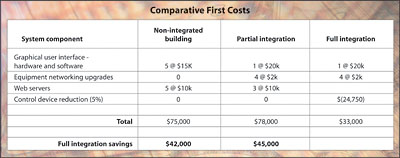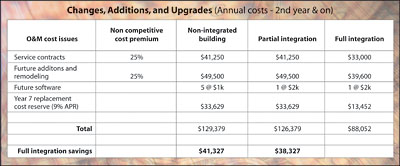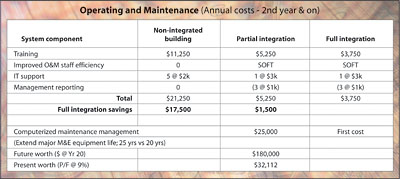
The IIBC reviews opportunities, sets strategies, takes action, and monitors initiatives that relate to integrated systems and automation in the large commercial building sector. Leading and visionary representation from all segments of the building industry includes manufacturers, service providers, building owners, and building professionals.
Specifically, IIBC Task Force 3 (TF3) addresses the LCC of intelligent and integrated BAS, which are the “hearts and souls” of “smart” buildings. Whereas, much of the green building initiative examines the “skin and skeleton” of an energy-efficient building, the IIBC TF3 concerns itself with the LCC of the “hearts, brains, organs, circulatory, and nervous systems” of the commercial building, which increases energy efficiency.
To accomplish the task of verifying the commercial building’s LCC, CABA will ask its members and other industry professionals to participate in a brief questionnaire that gives CABA the data needed to build a database of actual BAS costs. Much data already exists, but TF3 needs fresh, up-to-date data as technology advances continue to change our industry. The following gives a glimpse of TF3 accomplishment to date.
The chairman of the IIBC, Thomas J. Lohner, P.E., vice president of TENG Solutions, delivered the following report on LCC at the last TF3 meeting held on July 7, 2003. Lohner defined the benefits of LCC analysis for intelligent and integrated building systems in his presentation entitled “Analyzing the Life Cycle Cost of Integrated Building Systems: Traditional Approach vs. Integrated Approach.” In delivering this presentation, Lohner stated that the three approaches to intelligent building integration are:
- The traditional approach, which is
“non-integrated”;
- Partial integration; and
- Full integration.

Non-Integrated Approach
Lohner said that with the non-integrated approach, engineering is really left up to the contractors, because the building construction industry design professionals rely upon performance specifications and minimal design documentation to procure the various low voltage systems in a building.As a result, the real system engineering is performed during the construction phase as shop drawings, thus system integration is very difficult to accomplish. Performance specifications have evolved as the preferred delivery method for building automation and other low voltage systems, resulting from a lack of open communication standards for both control and data networks in the 1980s.
The lack of open standards resulted in proprietary, standalone systems and because the details of each system were unique to each manufacturer, and detailed engineering by design professionals was not possible for projects requiring competitive bidding.
Today, open control and data network standards exist, however the building construction industry has not evolved to take advantage of the system integration advantages associated with open standards. System integration can be specified, however, the final product and systems procured in a competitive bidding process are not known until after the subcontractor contract awards are finalized.
Consequently, the hardware and/or software required for system integration must be finalized after a contract is awarded and typically results in additional costs in the form of a contract change order. Another systems integration approach is to specify a sole source contractor to provide all required systems. This approach can be quite costly due to loss of competitive bidding.
If left non-integrated, the standalone systems are merely single-purpose and the system data that is generated provides no secondary benefits from a facility O&M perspective.

The Partial Integration Approach
With the partial integration concept, software is used to integrate the proprietary control subsystems on an Internet Protocol-based (IP) network. The software application program used to convert the proprietary system data into a common data format capable of being transported over an IP network is typically housed in hardware dedicated to provide both data conversion (gateway) and network routing functions. Today, it is possible to obtain software capable of converting the proprietary data into a Web format (HTML or XML), permitting the data to be displayed on a webpage, and viewable using a standard Web browser.The partial integration approach is hardware intensive, because multiple Web servers may be required, one for each proprietary subsystem.
However, there are benefits of partial integration over non-integration. The benefits of partial integration include:
- Single user interface for all systems.
- Web-based graphical user interface (GUI) becomes the de facto standard.
- System migration to open control networks which results in competitive bidding.
- Development of a centralized, campus-wide relational database which permits more effective maintenance management, a real opportunity for cost-saving energy management and the ability for progressive asset management.

The Full Integration Approach
In spite of the benefits derived from the partial integration approach, by utilizing an approach that is based on applying open- standards-based control subsystems, the full-integration concept is superior to them all. The fully integrated approach applies open standards wherever possible and/or practical. There is less hardware with the full-integration approach because integrating building control subsystems at the control network level reduces the number of Web servers required.In addition, the full integration approach reduces the number of devices, due to shared information throughout the system.
Of course, some of the benefits of the full-integration approach are the same as the benefits found in the partial integration approach, but there is so much more. The full-integration approach to building automation gives the owner:
- The ability to receive competitive bids for each building; and
- The integration of building subsystems, such as lighting, HVAC, power management, and security.
In addition to these benefits, the full integration approach produces the lowest LLC.

Systems Integration — Comparative LCC
The commercial building industry cannot afford not to consider integrated systems using open standards. Many of our public endusers must select systems based on their ability to offer the public-using agency the lowest LCC.This brings us to the question, “What costs constitute the full-integration LCC”? This list, while not all-inclusive, covers the majority of a BAS life-cycle. Costs include:
- First cost;
- Changes, additions, and upgrades;
- O&M; and
- Utility costs.
What are the LCC analysis assumptions?
To quantify the LCC, we chose a generic 150,000-sq-ft building. Standards tell us that the square foot cost of the major mechanical and electric equipment cost is $6/sq ft ($18/sq ft total). By federal acquisition regulations a proprietary systems life cycle is seven years, with a replacement cost of 125% of the initial system cost.Records also tell us that building owners replace 50% of the proprietary systems with next generation systems. In addition, owners replace 20% of the open systems due to age and obsolescence.
The industry average cost per control device is $400. Open and proprietary control devices base bid costs are the same. However, the following costs vary: training costs of $3,000 per GUI, $1,500 per protocol; plus 50% of first year cost for years two and up (Figures 1 and 2).

Changes, Additions, and Upgrades Issues
There will be a cost premium paid for additions and changes to proprietary controls. In addition, a proprietary system limits the scope of future improvements and modifications. On top of this, proprietary system manufacturers normally receive a cost premium for their non-competitive service contracts (Figure 3).
Summary
As documented in the presentation, today full integration results in the lowest net present value and, with advances in technology, the value of the integrated approach will only increase.For the building owners and managers, the exponential increase of information technology will be the competitive advantage.
TF3 is dedicated to quantifying and developing more detail regarding the various cost assumptions that are used in the LCC analysis of building technologies. The goal of the task force is to produce a white paper that outlines the factors that influence the cost assumptions and to provide ranges of expected values based on a survey of various existing buildings. In order to obtain non-biased information in this regard, the task force has prepared a Web-based survey to permit building owners and property managers to provide details regarding their existing building technologies.
Please help the development of the TF3 white paper by completing the BAS LCC survey questionnaire located at www.caba.org/aboutus/com-intelli.html. All participants in this Web survey will receive a free copy of the white paper when it is completed. Tentative completion date of the white paper is the first quarter of 2004. ES


